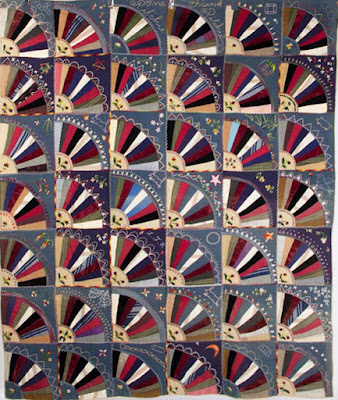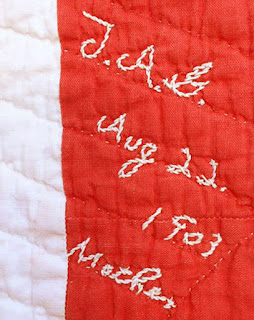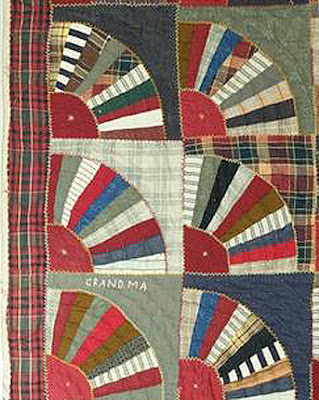Nothing makes a Quilt History Know-It-All more indignant than a myth repeated.
See the Six Know It Alls discuss Quilt Myths in this episode:
And myths repeated:
"Handed down from colonial days the Friendship Fan...."
From the Laura Wheeler syndicate in the 1930-1970 period.
Just how old is the fan pattern? Accuquilt asked me to do a short history of their new
Grandmother's Fan cutting die a while ago.
Short history! Don't get me started.
The earliest published pattern found so far is 1885 in
Peterson's Magazine
Was Jane Weaver recording what she saw going on in needlework
or inventing a trend?
1882-1883, Nebraska's Sheldon Museum
Anne Elizabeth Bascom North (1844-1923) Shoreham, Vermont
1886 Colonial Williamsburg
Anna Eliza Blackwell Clark, Maryland
The fan seems to have developed as a more controlled version of the Crazy quilt that became a nationwide fad in the early 1880s. Fans made good use of the same silk factory cutaways and offered many opportunities for the embroidery so popular after 1880.
1891
The style had rather strict rules: silks and mixed fabrics, beginning in the 1880s
when silk scraps were inexpensively available.
1893, Kentucky, National Museum of American History
The 1890s may have been the highpoint of the embroidered fan.
1894, Ima Frank Ritchie, Virginia
Also stitched of wools, lavished with the same kinds
of embroidery.
Black backgrounds a design necessity
Ethel, 1897
1896
Silk became scarce as world politics shut down Chinese imports. And the lavish embroidery lost some of the lavishness.
1898 in wools
1901-1902 West Virginia Project
After the turn of the 20th century we note a change in fabrics: Cottons---prints and woven pattern.
Yet embellished with embroidery.
1903 Columbia, Pennsylvania
1903, West Virginia project
Cretonnes and other cotton prints---embroidery and background
according to the old aesthetic.
What about a new aesthetic?
A glimpse....
Tan probably once green or blue.
1905, Four fans make a wheel.
This arrangement became increasing popular in the oughts.
1901, Alida Shave.
Fan has been forgotten, it's a wheel.
And then we go back to the Anna Tuels quilt in the Wadsworth
Athenaeum Collection, but it's not a fan; it's a wheel.
1905
1906 Mary Alma Turner, 8 years old
1910, Della Van Houghton Chase, Burlington, Michigan Project
Tradition persists.
1910
1906-1911 Arizona Project.
3 spokes per fan.
1912, Lizzie Miller, born about 1844,
may have thought the style cutting-edge modern.
1912 sampler of embroidered style
About this time Joseph Doyle & Company published a pattern
for "Grandmother's Fan," alluding to the old-fashionedness of the design.
In 1910 your grandma might have made one 25 years ago.
Doyle sold silk remnants, a continuation of grandmother's
sense of style.
1913 fan with a fancier edge, requiring applique
1918--- a throwback.
Did she see these as butterflies?
1929, pastels in fashion, wools appliqued to a crazy background.
1931
Finally, a new aesthetic. Pastels prints and plains, modern embroidery style
and is that the new packaged bias tape finishing out each fan/plate?
1932-1933 Oklahoma
And yet....in velvets
1949, Joan Marx
The new aesthetic. A love of prints---no embroidery necessary.
Fans like this were among the most popular designs in the mid-20th-century
but apparently few were date-inscribed.
Violet Moore Higgins illustration
A medieval princess?
Remember: Fans are NOT a Colonial pattern.
Or medieval.
Fanciful tales.


















































Such pretty fan/wheel quilts. Thanks for the history lesson.
ReplyDeleteIn the March 1884 Arthur's Home magazine, there is description in the Needlework Novelties that suggests using plush and velvet to make a sewed patchwork in the form of a widespread fan:
ReplyDeleteArthur’s Home Magazine, Volume 52, March 1884, Page 206
Fancy Needlework. Needlework Novelties.
A beautiful tidy for the back of a large chair is made of a square piece of cloth about ten inches each way; on this is sewed patchwork of plush and velvet in the form of a widespead fan. The corners of the block are of black velvet, and on the top, drooping over the fan, is a spray from a moss-rose bush in ribbon embroidery. The edge is finished with lace. The design is pretty for a block in a quilt or sofa pillow.